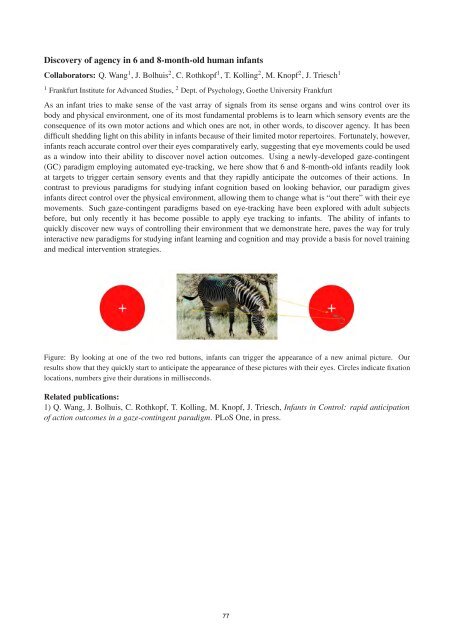FIAS Scientific Report 2011 - Frankfurt Institute for Advanced Studies ...
FIAS Scientific Report 2011 - Frankfurt Institute for Advanced Studies ...
FIAS Scientific Report 2011 - Frankfurt Institute for Advanced Studies ...
Create successful ePaper yourself
Turn your PDF publications into a flip-book with our unique Google optimized e-Paper software.
Discovery of agency in 6 and 8-month-old human infants<br />
Collaborators: Q. Wang 1 , J. Bolhuis 2 , C. Rothkopf 1 , T. Kolling 2 , M. Knopf 2 , J. Triesch 1<br />
1 <strong>Frankfurt</strong> <strong>Institute</strong> <strong>for</strong> <strong>Advanced</strong> <strong>Studies</strong>, 2 Dept. of Psychology, Goethe University <strong>Frankfurt</strong><br />
As an infant tries to make sense of the vast array of signals from its sense organs and wins control over its<br />
body and physical environment, one of its most fundamental problems is to learn which sensory events are the<br />
consequence of its own motor actions and which ones are not, in other words, to discover agency. It has been<br />
difficult shedding light on this ability in infants because of their limited motor repertoires. Fortunately, however,<br />
infants reach accurate control over their eyes comparatively early, suggesting that eye movements could be used<br />
as a window into their ability to discover novel action outcomes. Using a newly-developed gaze-contingent<br />
(GC) paradigm employing automated eye-tracking, we here show that 6 and 8-month-old infants readily look<br />
at targets to trigger certain sensory events and that they rapidly anticipate the outcomes of their actions. In<br />
contrast to previous paradigms <strong>for</strong> studying infant cognition based on looking behavior, our paradigm gives<br />
infants direct control over the physical environment, allowing them to change what is “out there” with their eye<br />
movements. Such gaze-contingent paradigms based on eye-tracking have been explored with adult subjects<br />
be<strong>for</strong>e, but only recently it has become possible to apply eye tracking to infants. The ability of infants to<br />
quickly discover new ways of controlling their environment that we demonstrate here, paves the way <strong>for</strong> truly<br />
interactive new paradigms <strong>for</strong> studying infant learning and cognition and may provide a basis <strong>for</strong> novel training<br />
and medical intervention strategies.<br />
Figure: By looking at one of the two red buttons, infants can trigger the appearance of a new animal picture. Our<br />
results show that they quickly start to anticipate the appearance of these pictures with their eyes. Circles indicate fixation<br />
locations, numbers give their durations in milliseconds.<br />
Related publications:<br />
1) Q. Wang, J. Bolhuis, C. Rothkopf, T. Kolling, M. Knopf, J. Triesch, Infants in Control: rapid anticipation<br />
of action outcomes in a gaze-contingent paradigm. PLoS One, in press.<br />
77
















